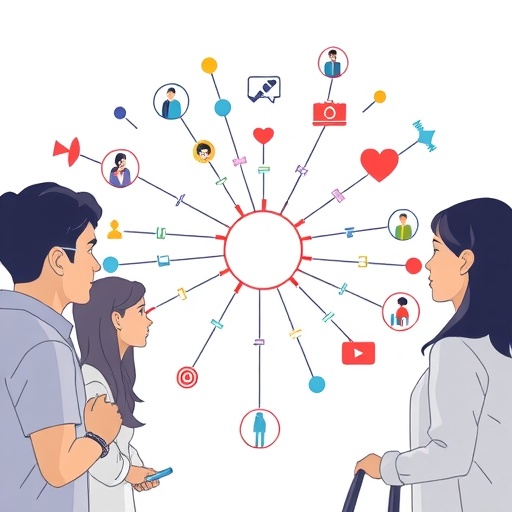The unprecedented global shift brought about by the COVID-19 pandemic has profoundly reshaped the social and psychological landscapes, especially among college students. A new study published in BMC Psychiatry delves into the intricate dynamics between social support systems and anxiety symptoms in this vulnerable population, employing advanced network analysis techniques. This investigative approach transcends traditional methods by focusing not merely on general impairment but on the nuanced interplay of individual anxiety symptoms and types of perceived social support.
Central to the study is the differentiation of social support into three pivotal domains: family support, friend support, and other social support. By dissecting these categories, researchers sought to illuminate how each distinct source influences particular anxiety symptoms during a time characterized by isolation, uncertainty, and rapid lifestyle transitions. The pandemic context served as a natural experiment for examining the evolving role of social networks when physical interaction was severely limited, intensifying emotional and psychological strain.
The research involved an extensive sample of 4,105 college students who participated in two waves of assessment, referred to as T1 and T2. Network analysis, a method that visualizes and quantifies relationships among symptoms and supports, allowed the team to identify bridge nodes—specific elements that connect social support facets with anxiety manifestations. This technique sheds light on which types of support have the greatest potential to buffer anxiety symptoms and which may inadvertently exacerbate them.
At both measured time points, perceived social support emerged as a significant factor linked to anxiety symptoms, yet its effects varied according to the source. Family support consistently acted as a protective agent, correlating negatively with several distressing symptoms. This suggests that the presence of a reliable, nurturing family environment may effectively mitigate the psychological toll experienced by students during pandemic-induced adversities.
Intriguingly, friend support demonstrated a more complex relationship with anxiety symptoms. While it appeared to decrease certain symptoms such as uncontrollable worry, it was simultaneously associated with increases in other symptoms, including irritability. This paradox may reflect the multifaceted nature of peer interactions, which can provide comfort while also introducing stressors, especially when social contact is constrained and communication dynamics are altered.
The dimension termed “other support” showed less consistent effects and appeared to diminish in influence over time. This decline underscores how the quality and source of support may shift as pandemic conditions evolve and as students adapt their coping mechanisms and social networks in response to ongoing challenges.
Methodologically, the study’s use of network comparison tests (NCT) enabled the researchers to compare the configuration and strength of symptom-support relationships at different time points. This temporal analysis affirmed that the protective hallmark of family support persisted steadfastly, while friend support’s influence waned, highlighting the fluidity of social support systems amid changing external stressors.
The findings carry profound implications for mental health interventions tailored to college populations. Recognizing family support as a critical protective factor may encourage strategies that bolster familial engagement and communication, even within geographically dispersed or strained family units. Additionally, understanding the dualistic nature of friend support could guide programs to foster healthier peer interactions and manage potential interpersonal sources of anxiety.
Importantly, this symptom-level analysis sheds light on the granular mechanisms by which social support buffers anxiety, advocating for mental health models that accommodate the heterogeneity of symptom experiences rather than treating anxiety as a singular, monolithic condition. Such precision can enhance the customization of therapeutic approaches and boost their effectiveness in dynamic, real-world contexts.
As students transition out of stringent pandemic restrictions, the evolution of support networks and their psychological impact remain pertinent. The attenuation of friend and other support’s protective roles may signal the need for continuous monitoring and adaptive support systems that respond flexibly to students’ altering environments and emotional needs.
In summary, this research pioneers a refined lens into the interplay between social support and anxiety during an unparalleled societal stressor. It situates family support as a cornerstone of resilience while inviting a nuanced understanding of social interactions’ dual nature. These insights not only enrich academic discourse but also offer practical routes to enhance mental well-being among college populations navigating the post-pandemic world.
Future investigations building on this work could explore the cultural and demographic moderators that shape these networks, as well as potential digital interventions that substitute or supplement traditional support systems in times when physical proximity is unavailable. The integration of network analysis with longitudinal designs promises a sophisticated toolkit for dissecting mental health complexities in a rapidly changing social milieu.
By unravelling the distinct pathways through which social support mediates mental health symptoms, this study sets a precedent for holistic, data-driven approaches to psychological research and intervention. It underscores the necessity of framing social support not as a generic buffer but as a multifaceted construct with varying influences contingent on source, context, and symptom profile.
Subject of Research: The relationships between perceived social support dimensions and individual anxiety symptoms among college students during the COVID-19 pandemic.
Article Title: Network analysis of social support and anxiety symptoms among college students during the COVID-19 pandemic
Article References:
Feng, T., Ren, L., Zhang, G. et al. Network analysis of social support and anxiety symptoms among college students during the COVID-19 pandemic. BMC Psychiatry 25, 842 (2025). https://doi.org/10.1186/s12888-025-07215-2
Image Credits: AI Generated




